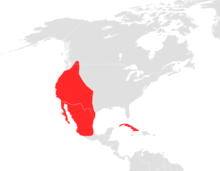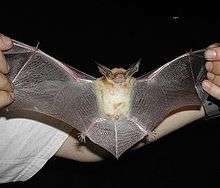Pallid bat
| Pallid bat | |
|---|---|
.jpg) | |
| Scientific classification | |
| Kingdom: | Animalia |
| Phylum: | Chordata |
| Class: | Mammalia |
| Order: | Chiroptera |
| Family: | Vespertilionidae |
| Subfamily: | Vespertilioninae |
| Tribe: | Antrozoini |
| Genus: | Antrozous H. Allen, 1862 |
| Species: | A. pallidus |
| Binomial name | |
| Antrozous pallidus (LeConte, 1856)[2] | |
 | |
| Pallid Bat range | |
The pallid bat (Antrozous pallidus) is a species of bat that ranges from western Canada to central Mexico. It is the sole species of its genus and is closely related to Van Gelder's bat (Bauerus dubiaquercus), which is sometimes included in Antrozous.[3] Although it has in the past been placed in its own subfamily (Antrozoinae) or even family (Antrozoidae), it is now considered part of the subfamily Vespertilioninae and the tribe Antrozoini.[4]
Description
Pallid bats have a head and body length of approximately 2.75 inches (6.2-7.9 cm), a tail of approximately 1.75 inches (3.9-4.9 cm), and a wingspan of 15-16 inches (38–40 cm).[5][6] They weigh 14-25 grams. These bats are large, with long forward pointing ears (over 2.5 cm). Fur is pale at the roots, brown on their back, with a light underside. Pallid bats have a blunt piglike snout.[5]
Ecology
.jpg)
Pallid bats are typically found in arid or semi-arid habitats, often in mountainous or rocky areas near water. They are also found over open, sparsely vegetated grasslands, and they seem to prefer to forage in the open. The pallid bat uses three different roosts: a day roost, a night roost for consuming prey, and a hibernation roost for the winter months. The day roost is usually in a warm, horizontal opening such as in attics or rock cracks; the night roost is usually in the open, near foliage; and the hibernation roost, which is often in buildings, caves, or cracks in rocks.[7]
Pallid bats are insectivores that feed on arthropods such as crickets and scorpions, and are capable of consuming up to half their weight in arthropods every night. Pallid bats are gleaners, capturing prey from the ground and transporting it to their night roost for consumption. When foraging, pallid bats typically fly at low heights of 1–2 m off the ground.[5][7]
Pallid bats are a unique bat species because they are heterothermic, meaning they can be either poikilothermic or homoeothermic depending on the time of year. They have the ability to control their body temperature and equilibrate it with the environment during winter hibernation and whenever they rest.[8]
Behavior and natural history

The mating season ranges from October to February. The female bat gives birth to twins during early June; they weigh about 3 to 3.5 g (0.11 to 0.12 oz) at birth and in four or five weeks are capable of making short flights. They do not attain adult size until about eight weeks of age, and do not become sexually mature until after around two years.
Like the majority of bat species, pallid bats are capable of using echolocation while foraging and traveling from their roost sites to foraging grounds. However, they may also opt to not echolocate while foraging, and instead use their large ears to locate insects on the ground.[9]
See also
References
- ↑ Arroyo-Cabrales, J. & de Grammont, P.C. (2008). "Antrozous pallidus". IUCN Red List of Threatened Species. Version 2009.2. International Union for Conservation of Nature. Retrieved 7 February 2010.
- ↑ Simmons, Nancy B. (1998). T.H. Kunz and P.A. Racey, eds. "A reappraisal of interfamilial relationships of bats". Bat Biology and Conservation (Smithsonian Institution Press): 3–26.
- ↑ Simmons, Nancy B. (2005). "Order Chiroptera". In Wilson, Don E.; Reeder, DeeAnn M. Mammal Species of the World: A Taxonomic and Geographic Reference. Johns Hopkins University Press. pp. 498–499. ISBN 978-0-8018-8221-0.
- ↑ Roehrs, Z.P.; Lack, J.B.; Van Den Bussche, R.A. (2010). "Tribal phylogenetic relationships within Vespertilioninae (Chiroptera: Vespertilionidae) based on mitochondrial and nuclear sequence data". Journal of Mammalogy 91 (5): 1073–1092. doi:10.1644/09-MAMM-A-325.1.
- 1 2 3 Reid, Fionna. Mammals of North America. Peterson Field Guides. pp. 423–424. ISBN 0395935962.
- ↑ "Animal Fact Sheet: Pallid bat". Desert Museum.
- 1 2 "Antrozous pallidus". IUCN Red List of Threatened Species. Retrieved 18 December 2015.
- ↑ "Antrozous pallidus pallid bat". Animal Diversity Web.
- ↑ "California Wildlife Habitat Relationships System -- Pallid Bat".
- Cunningham,Eric. "About Bats & Blood." http://ebat.tamu.edu/. 15, August 2003. Cardiovascular Systems Dynamics Lab. 11 Feb 2007 <http://ebat.tamu.edu/bats/>.
- Rambaldini, Daniela A. 2005. Antrozous pallidus, Pallid bat. WBWG Species Account.
- Species Profile at Bat Conservation International
- Rambaldini, Daniela A. and R. M. Brigham. 2008. Torpor use by free-ranging pallid bats (Antrozous pallidus) at the northern extent of their range. Journal of Mammalogy. 89(4): 933–941.
- Rambaldini, Daniela A. and R. M. Brigham. 2011. Pallid bat (Antrozous pallidus) foraging over native and vineyard habitat in British Columbia, Canada. Canadian Journal of Zoology. 89: 816-822.
External links
| Wikimedia Commons has media related to Antrozous pallidus. |
![]() Data related to Antrozous pallidus at Wikispecies
Data related to Antrozous pallidus at Wikispecies
